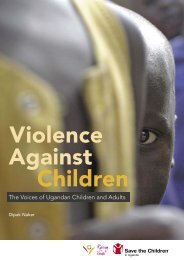Mobilising Communities to Prevent - Raising Voices
Mobilising Communities to Prevent - Raising Voices
Mobilising Communities to Prevent - Raising Voices
- No tags were found...
Create successful ePaper yourself
Turn your PDF publications into a flip-book with our unique Google optimized e-Paper software.
preface<br />
The call for an end <strong>to</strong> violence against women is growing ever louder. Increasingly, women’s<br />
rights are seen as a corners<strong>to</strong>ne in the promotion of human rights and the realization of<br />
social justice. Clearly, women cannot live free, safe, and dignified lives when violence, or<br />
the threat of violence, pervades their public and private experiences. Without the basic right <strong>to</strong><br />
live free from fear, all other gains are compromised.<br />
Violence against women is now recognized as a priority issue not only in the United Nations (UN)<br />
but also in many international agencies and local non-governmental organisations (NGOs)<br />
around the world. The challenge for activists now is <strong>to</strong> translate these visions of women’s rights<br />
in<strong>to</strong> practical projects and activities that promote meaningful change in the lives of women, men,<br />
families, and communities.<br />
preface<br />
Community-based non-governmental organisations are at the forefront of many of these efforts.<br />
These groups are embracing the idea of universal human rights and working with communities <strong>to</strong><br />
create environments where all members can live free, safe, and dignified lives.<br />
The Resource Guide aims <strong>to</strong> help organisations translate the vision of women’s rights in<strong>to</strong> action.<br />
It is a <strong>to</strong>ol for organisations committed <strong>to</strong> preventing domestic violence through the promotion of<br />
women’s rights. It is designed <strong>to</strong> assist organisations in (a) facilitating a change in community<br />
beliefs that accept and maintain a culture of violence and (b) building community support<br />
structures that value women and are supportive of women’s rights. Placing the responsibility for<br />
both squarely on the community, the role of the<br />
organisation undertaking this work is <strong>to</strong><br />
organise, inspire, support, and<br />
challenge the community <strong>to</strong><br />
envision and create a safer<br />
environment for women.<br />
Conceptualizing<br />
Domestic Violence<br />
Among activists<br />
addressing violence<br />
against women, there is a<br />
healthy debate about what is, or should be, meant<br />
by the word ‘violence’. This is important because how we understand violence deeply influences<br />
how we work <strong>to</strong> prevent it. Some activists argue that domestic violence is best defined in narrow<br />
and specific terms so that it can be studied and quantified meaningfully and responded <strong>to</strong> more<br />
effectively. A narrow definition usually limits domestic violence <strong>to</strong> physical and sexual acts of<br />
aggression and excludes psychological abuse. Some argue that if a broad definition of violence<br />
is used, efforts <strong>to</strong> prevent it become <strong>to</strong>o scattered, progress is difficult <strong>to</strong> measure, and activists<br />
risk losing credibility.<br />
<strong>Mobilising</strong> <strong>Communities</strong> <strong>to</strong> <strong>Prevent</strong> Domestic Violence<br />
7
















